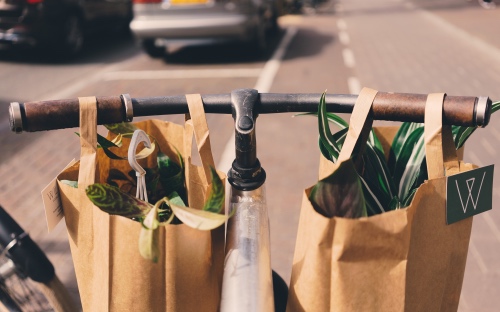
As bans on single-use plastic bags become more commonplace, TREVOR THORNTON, lecturer in the School of Life and Environmental Sciences at Australia’s Deakin University, looks, in an article first published on The Conversation, at how many times shoppers need to use reusable bags to compensate for their larger environmental impact…
The plastic bag ban by the major supermarkets (and Coles’ pivot away from its ban after backlash, then pivot back to the ban after a backlash to the backlash) has left plenty of people scratching their heads.
What are the best replacements for single-use plastic bags? Given that reusable bags are much sturdier, how many times must we use them to compensate for their larger environmental impact?

Paper, not plastic. PICTURE: Guus Baggermans/Unsplash
“It’s worth noting that, according to [a] 2018 Danish study, using organic cotton has a greater environmental impact than non-organic due to higher production costs. Our assumptions about what is environmentally friendly don’t always stand up to scrutiny.”
The simple answer is that there is no simple answer. However, a kind of research called “life cycle assessment” can help us work out the impact of common types of reusable bags.
Life cycle assessments
I am not aware of any Australian studies of plastic-bag substitutes. Research conducted overseas can offer a basic guide.
Life cycle assessments consider a wide range of factors, including raw materials, manufacturing, transport, and eventual disposal.
Looking at all of these elements, researchers calculate greenhouse gas emissions, waste disposal, water and energy consumption and a variety of other impacts.
To complicate the decision further, if you choose a plastic bag, is it made from virgin resin or from recycled plastic? Even if the bag is recycled, transport is an issue – where was it made? Printing on the bag also adds to the environmental burden.
Finally, what happens to the bags when they can no longer meet their purpose? Are they recycled, reused as bin liners, or thrown away immediately?
How many times must a bag be reused?
Once all of this information has been distilled, scientists can usually offer a fairly straightforward guide: the number of times a given bag should be reused when compared to the standard supermarket plastic bag.
A 2018 Danish study, looking at the number of times a bag should be reused before being used as a bin liner and then discarded, found that:
• polypropylene bags (most of the green reusable bags found at supermarkets) should be used 37 times
• paper bags should be used 43 times
• cotton bags should be used 7,100 times.
Another UK study, which only considered the climate change impact, found that to have lower global warming potential than single-use plastic bags:
• paper bags should be used three times
• low-density polyethylene bags (the thicker plastic bags commonly used in supermarkets) should be used four times
• non-woven polypropylene bags should be used 11 times
• cotton bags should be used 131 times.
Note, however, that if a plastic bag is reused (even as a bin liner) the number of times an alternative needs to be used increases.
It’s worth noting that, according to the 2018 Danish study, using organic cotton has a greater environmental impact than non-organic due to higher production costs. Our assumptions about what is environmentally friendly don’t always stand up to scrutiny.
A 2014 study in the United States found that reusable LDPE and polypropylene bags do have a lower environmental impact than the usual plastic bags found in supermarkets – but only if they are reused enough times. This study found that about 40 per cent of shoppers forgot to bring their reusable bags and therefore end up using the plastic bags. This then adds to the environmental burden of shopping.
One final consideration is how many bags you need. The Danish researchers equalised the volume of the bags so that evaluations were made on the same volume of space (this meant that for some assessments it was necessary to consider the impact of two bags).
As with all matters environmental, it’s essential that we have the right knowledge to make informed decisions. After looking at all this data, here are the things I’d like you to remember:
1. whatever bag type you use, use it as many times as possible;
2. choose bags made from recyclable materials;
3. avoid bags that have printing or decorations – these alone can add significantly to the environmental burden of the bag; and,
4. never allow a bag to become litter – recycle, reuse and repurpose your bags.
Trevor Thornton is a lecturer in the School of Life and Environmental Sciences at Deakin University. This article was originally published on The Conversation. Read the original article.





